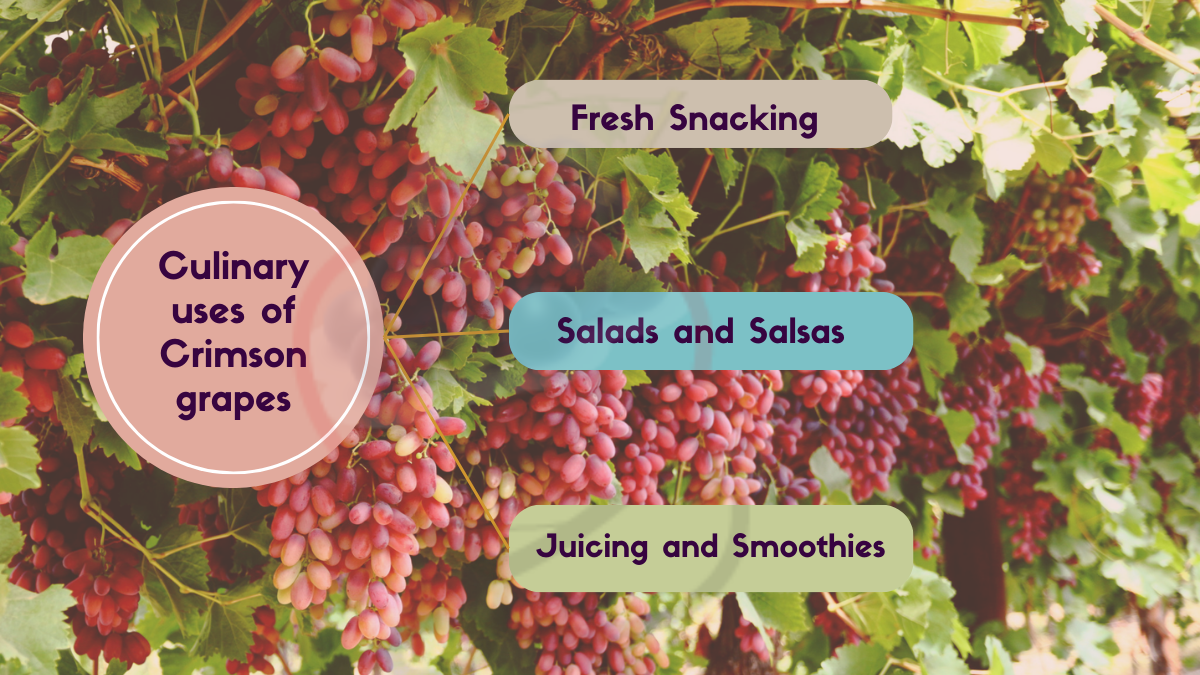Crimson Seedless grapes are big, red, and don’t have any seeds. They have a thick, tough skin and juicy, crunchy insides. [1]
They don’t have a strong taste. When they grow on the vine, they form medium-sized bunches that are sort of cone-shaped and filled with grapes.
In this article, we will talk about the crimson grapes, exploring their origins, nutritional value, and culinary uses.

Origin of Crimson Grapes
Crimson grapes, also known as red table grapes, have a rich history that dates back centuries.
These succulent grapes are a variety of Vitis vinifera, the common grape vine, and are believed to have originated in the Mediterranean region.
With their distinctive crimson hue and sweet, juicy flavor, crimson grapes quickly gained popularity and are now grown in vineyards around the world.
Nutritional Values of Crimson Grapes
- Calories: 69 kcal
- Carbohydrates: 18 grams
- Sugars: 16 grams
- Dietary Fiber: 0.9 grams
- Protein: 0.7 grams
- Fat: 0.2 grams
- Vitamins and Minerals
- Vitamin C: 10.2 mg (17% of the Daily Value)
- Vitamin K: 22.4 mcg (28% of the Daily Value)
- Vitamin B6: 0.086 mg (4% of the Daily Value)
- Potassium: 191 mg (5% of the Daily Value)
- Manganese: 0.071 mg (4% of the Daily Value)
Characteristics of Crimson grapes

- They are a late-season variety, typically ripening in October or November.
- They are a high-yielding variety, with yields of up to 10 tons per acre.
- They are a resistant variety, with good resistance to diseases such as powdery mildew and black rot.
- They are a versatile variety, and can be eaten fresh, used in salads, or made into wine.
Culinary Uses

1: Fresh Snacking
Crimson grapes are a perfect on-the-go snack. Their natural sweetness makes them an ideal choice for satisfying your sweet tooth without resorting to unhealthy options.
2: Salads and Salsas
Add a burst of flavor to your salads and salsas by incorporating crimson grapes. Their juiciness complements various vegetables and herbs, creating a delightful contrast of textures.
3: Juicing and Smoothies
Blend crimson grapes into your morning smoothie for a sweet and nutritious kick start to your day. You can also juice them for a refreshing beverage that’s rich in vitamins and antioxidants.
Health Benefits of Crimson Grapes

1: Heart Health
The antioxidants [2] in crimson grapes have been linked to heart health. They help reduce cholesterol levels and maintain healthy blood pressure, lowering the risk of cardiovascular diseases.
2: Digestive Aid
The fiber in these grapes aids in digestion by promoting regular bowel movements and preventing constipation. [3]
3: Skin Care
The vitamin C content in crimson grapes contributes to collagen production, keeping your skin healthy and radiant. [4]
Incorporating crimson grapes into your diet is a delicious and nutritious choice.
From their rich history to their impressive health benefits, these grapes have earned their place as a beloved snack and ingredient in various culinary creations.
FAQs
Are crimson grapes the same as red grapes?
No, crimson grapes are a specific variety of red grapes known for their vibrant color and sweet flavor.
Can crimson grapes help with weight management?
Yes, the dietary fiber in crimson grapes can aid in weight management by promoting a feeling of fullness.
Are there any side effects of consuming crimson grapes?
Generally, crimson grapes are safe to consume in moderation. However, some people may experience digestive discomfort if consumed in excess.
Can crimson grapes be part of a diabetic diet?
While crimson grapes contain natural sugars, they can be included in a diabetic diet in moderation, as they have a lower glycemic index compared to some other fruits.
How should I store crimson grapes to keep them fresh?
Store crimson grapes in the refrigerator to maintain their freshness. They can also be frozen for longer storage.

